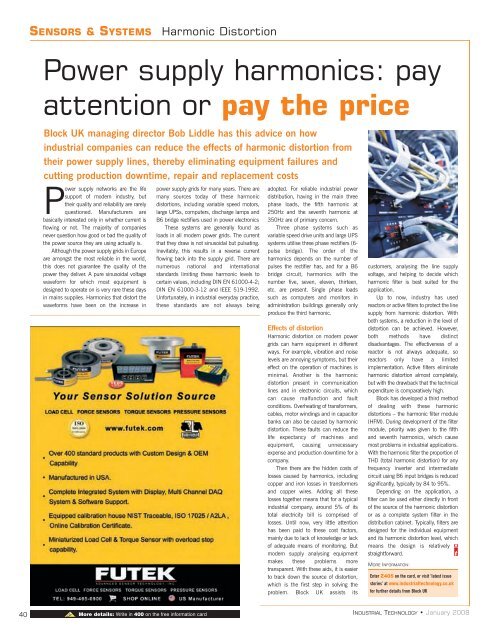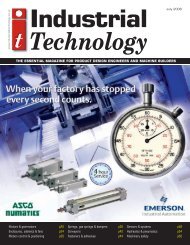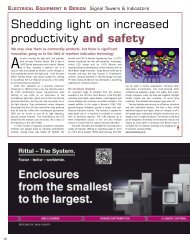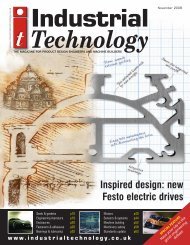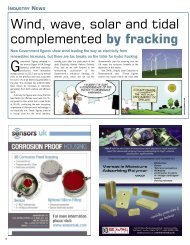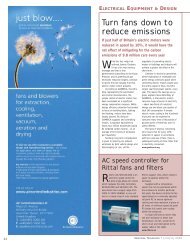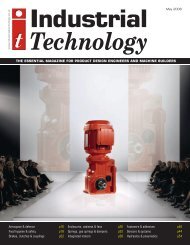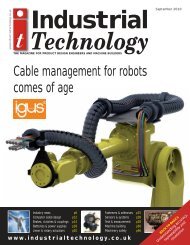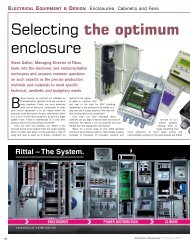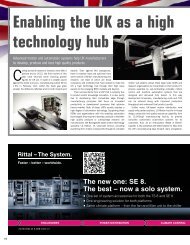IT Jan 2008 - Industrial Technology Magazine
IT Jan 2008 - Industrial Technology Magazine
IT Jan 2008 - Industrial Technology Magazine
You also want an ePaper? Increase the reach of your titles
YUMPU automatically turns print PDFs into web optimized ePapers that Google loves.
SENSORS & SYSTEMS<br />
Harmonic Distortion<br />
Power supply harmonics: pay<br />
attention or pay the price<br />
Block UK managing director Bob Liddle has this advice on how<br />
industrial companies can reduce the effects of harmonic distortion from<br />
their power supply lines, thereby eliminating equipment failures and<br />
cutting production downtime, repair and replacement costs<br />
Power supply networks are the life<br />
support of modern industry, but<br />
their quality and reliability are rarely<br />
questioned. Manufacturers are<br />
basically interested only in whether current is<br />
flowing or not. The majority of companies<br />
never question how good or bad the quality of<br />
the power source they are using actually is.<br />
Although the power supply grids in Europe<br />
are amongst the most reliable in the world,<br />
this does not guarantee the quality of the<br />
power they deliver. A pure sinusoidal voltage<br />
waveform for which most equipment is<br />
designed to operate on is very rare these days<br />
in mains supplies. Harmonics that distort the<br />
waveforms have been on the increase in<br />
power supply grids for many years. There are<br />
many sources today of these harmonic<br />
distortions, including variable speed motors,<br />
large UPSs, computers, discharge lamps and<br />
B6 bridge rectifiers used in power electronics<br />
These systems are generally found as<br />
loads in all modern power grids. The current<br />
that they draw is not sinusoidal but pulsating.<br />
Inevitably, this results in a reverse current<br />
flowing back into the supply grid. There are<br />
numerous national and international<br />
standards limiting these harmonic levels to<br />
certain values, including DIN EN 61000-4-2;<br />
DIN EN 61000-3-12 and IEEE 519-1992.<br />
Unfortunately, in industrial everyday practice,<br />
these standards are not always being<br />
adopted. For reliable industrial power<br />
distribution, having in the main three<br />
phase loads, the fifth harmonic at<br />
250Hz and the seventh harmonic at<br />
350Hz are of primary concern.<br />
Three phase systems such as<br />
variable speed drive units and large UPS<br />
systems utilise three phase rectifiers (6-<br />
pulse bridge). The order of the<br />
harmonics depends on the number of<br />
pulses the rectifier has, and for a B6<br />
bridge circuit, harmonics with the<br />
number five, seven, eleven, thirteen,<br />
etc. are present. Single phase loads<br />
such as computers and monitors in<br />
administration buildings generally only<br />
produce the third harmonic.<br />
Effects of distortion<br />
Harmonic distortion on modern power<br />
grids can harm equipment in different<br />
ways. For example, vibration and noise<br />
levels are annoying symptoms, but their<br />
effect on the operation of machines is<br />
minimal. Another is the harmonic<br />
distortion present in communication<br />
lines and in electronic circuits, which<br />
can cause malfunction and fault<br />
conditions. Overheating of transformers,<br />
cables, motor windings and in capacitor<br />
banks can also be caused by harmonic<br />
distortion. These faults can reduce the<br />
life expectancy of machines and<br />
equipment, causing unnecessary<br />
expense and production downtime for a<br />
company.<br />
Then there are the hidden costs of<br />
losses caused by harmonics, including<br />
copper and iron losses in transformers<br />
and copper wires. Adding all these<br />
losses together means that for a typical<br />
industrial company, around 5% of its<br />
total electricity bill is comprised of<br />
losses. Until now, very little attention<br />
has been paid to these cost factors,<br />
mainly due to lack of knowledge or lack<br />
of adequate means of monitoring. But<br />
modern supply analysing equipment<br />
makes these problems more<br />
transparent. With these aids, it is easier<br />
to track down the source of distortion,<br />
which is the first step in solving the<br />
problem. Block UK assists its<br />
customers, analysing the line supply<br />
voltage, and helping to decide which<br />
harmonic filter is best suited for the<br />
application.<br />
Up to now, industry has used<br />
reactors or active filters to protect the line<br />
supply from harmonic distortion. With<br />
both systems, a reduction in the level of<br />
distortion can be achieved. However,<br />
both methods have distinct<br />
disadvantages. The effectiveness of a<br />
reactor is not always adequate, so<br />
reactors only have a limited<br />
implementation. Active filters eliminate<br />
harmonic distortion almost completely,<br />
but with the drawback that the technical<br />
expenditure is comparatively high.<br />
Block has developed a third method<br />
of dealing with these harmonic<br />
distortions – the harmonic filter module<br />
(HFM). During development of the filter<br />
module, priority was given to the fifth<br />
and seventh harmonics, which cause<br />
most problems in industrial applications.<br />
With the harmonic filter the proportion of<br />
THD (total harmonic distortion) for any<br />
frequency inverter and intermediate<br />
circuit using B6 input bridges is reduced<br />
significantly, typically by 84 to 95%.<br />
Depending on the application, a<br />
filter can be used either directly in front<br />
of the source of the harmonic distortion<br />
or as a complete system filter in the<br />
distribution cabinet. Typically, filters are<br />
designed for the individual equipment<br />
and its harmonic distortion level, which<br />
means the design is relatively<br />
straightforward.<br />
MORE INFORMATION:<br />
Enter Z405 on the card, or visit ‘latest issue<br />
stories’ at www.industrialtechnology.co.uk<br />
for further details from Block UK<br />
40<br />
More details: Write in 400 on the free information card<br />
INDUSTRIAL TECHNOLOGY • <strong>Jan</strong>uary <strong>2008</strong>


